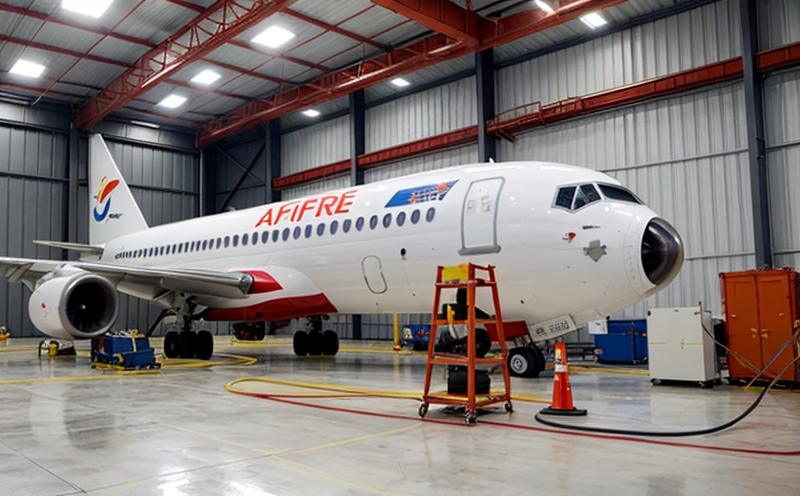ASTM E162 Surface Flammability Testing for Aircraft Interiors
The ASTM E162 standard is a critical component in the evaluation of flame resistance for materials used in aircraft interiors. This test measures the surface flammability properties of materials under conditions that mimic those encountered during an actual fire event. The primary purpose is to ensure that any material used within the aircraft cabin adheres to stringent safety regulations set forth by aviation authorities such as FAA, EASA, and other global standards bodies.
The testing process involves exposing a standardized specimen to a precisely controlled flame source for a defined duration. During this exposure, parameters like burn length, afterglow time, and char depth are carefully measured. The goal is to determine whether the material will spread fire or remain non-flammable under specified conditions. This information helps manufacturers select appropriate materials that meet regulatory requirements without compromising on comfort or functionality.
For aerospace applications specifically, there are unique challenges due to the confined space of aircraft cabins and the high concentration of people in such environments. Materials must not only be flame-resistant but also lightweight, durable, and aesthetically pleasing. ASTM E162 plays a vital role by providing a consistent method for evaluating these properties across different materials, ensuring safety without sacrificing design integrity.
One key aspect of this testing is the use of standardized specimens which are carefully prepared according to specified dimensions and weight tolerances. The apparatus used includes a regulated flame source designed to replicate real-world fire scenarios accurately. Once ignited, the specimen remains exposed for exactly 15 seconds before being quenched automatically. After cooling down, detailed observations about flaming behavior, char formation, and other relevant characteristics are recorded.
The results of ASTM E162 testing provide valuable insights into how a material behaves when subjected to flames. These outcomes guide manufacturers in making informed decisions regarding the choice of materials for various aircraft interior components like seat cushions, armrests, ceiling panels, and floor coverings. By adhering to this standard, companies can demonstrate their commitment to passenger safety while meeting stringent regulatory expectations.
It's important to note that ASTM E162 testing isn't just about compliance; it also serves as a tool for continuous improvement in material science. As technology advances and new materials are developed, the results from these tests help refine future designs ensuring they remain safe even under extreme conditions.
Scope and Methodology
The ASTM E162 surface flammability test is designed to evaluate the flame resistance of materials used in aircraft interiors. Specifically, it assesses how a material responds when exposed to an open flame for a short period (typically 15 seconds). The scope includes all types of fabrics, foams, plastics, and other textiles that may come into contact with passengers or be located within easy reach during flight.
- Flame Source: A gas jet flame source is used to provide a controlled environment for testing. This ensures uniformity in the application of heat across samples.
- Sample Preparation: Specimens must be cut according to precise dimensions and weights provided by ASTM E162 guidelines. Preparing specimens correctly is crucial as it directly impacts the accuracy of test results.
- Data Collection: During testing, various parameters are measured including burn length, afterglow duration, and char formation patterns. These metrics provide comprehensive data on a material's flammability characteristics.
The methodology outlined in ASTM E162 ensures that all tests conducted follow standardized procedures, reducing variability and enhancing comparability between different laboratories performing the same tests.
Quality and Reliability Assurance
The quality and reliability of ASTM E162 testing are paramount in ensuring passenger safety within aircraft interiors. Laboratories must adhere strictly to all procedures prescribed by the standard, which includes precise control over environmental conditions such as temperature, humidity, and pressure.
To maintain consistency, laboratories use calibrated equipment for measuring key parameters like flame height, burn length, and afterglow time. Regular calibration of instruments is essential to ensure accurate readings every time a test is conducted. Additionally, personnel involved in the testing process undergo rigorous training to understand both theoretical aspects of fire science as well as practical skills required during actual tests.
Quality assurance measures extend beyond technical specifications; they also encompass robust quality control programs aimed at preventing errors or inconsistencies throughout the entire testing lifecycle—from sample preparation through final reporting. By implementing strict protocols and continuous monitoring, laboratories can guarantee that each test result accurately reflects the true flammability properties of a given material.
Reliability in ASTM E162 testing is further enhanced by independent third-party audits conducted periodically to verify compliance with all relevant standards. Such external evaluations help identify potential areas for improvement and reinforce trust among stakeholders involved in aircraft manufacturing processes.
Use Cases and Application Examples
- Aircraft Cabin Linings: Ensuring that seat covers, armrests, and other cabin furnishings comply with safety regulations is essential. ASTM E162 testing helps manufacturers select materials that won't contribute to the spread of fire during an emergency.
- Emergency Exit Signs: The lighting systems within aircraft cabins must remain functional even if powered by batteries alone. Testing these components ensures they continue working correctly after exposure to flames.
- Fire Extinguisher Covers: These protect vital firefighting equipment from accidental damage during normal operations or emergencies. ASTM E162 helps verify that coverings are both flame-resistant and durable enough for their intended purpose.
- Floor Coverings: Non-slip mats and carpets need to withstand high temperatures without catching fire easily. This testing ensures they meet necessary safety standards.
- In-Flight Entertainment Systems: Electronics integrated into aircraft interiors must pass rigorous tests to ensure they don't pose a risk of ignition or explosion when exposed to flames.
By incorporating ASTM E162 surface flammability testing into their development processes, manufacturers can rest assured that their products contribute positively towards enhancing passenger safety onboard commercial flights and general aviation aircraft alike.





